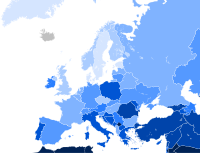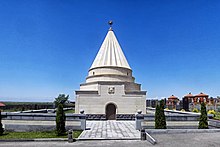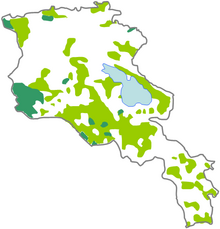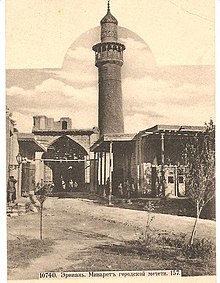Religion in Armenia
As of 2011, most Armenians are Christians (97%)[1] and are members of Armenia's own church, the Armenian Apostolic Church, which is one of the oldest Christian churches. It was founded in the 1st century AD, and in 301 AD became the first branch of Christianity to become a state religion.
According to Pew Research publication in December 2018 Armenia is the 2nd most religious country among 34 European nations with 80% of respondents saying they believe in God with absolute certainty.[3]
In the 21st century, the largest minority Christian churches in the country are composed of new converts to Protestant and non-trinitarian Christianity, a combined total up to 38,989 persons (1.3%). Due to the country's ethnic homogeneity, non-Christian religions such as Yazidism and Islam have only a few adherents.[4]
Religious demography[]

Approximately 98.1% of the country's population is ethnic Armenian. Armenians have a very strong cultural connection to the Armenian Apostolic Church. About 97% of citizens belong to the Armenian Apostolic Church, an Eastern Christian denomination in communion with the other Oriental Orthodox churches. The Armenian Apostolic Church has its spiritual center at the Etchmiadzin Cathedral. The head of the church is Catholicos Karekin II.
According to the Census of 2011, the composition of people identifying with religions in Armenia is the following: Christianity 2,862,366 (99%), of whom 2,797,187 are Armenian Apostolic (97%); 29,280 Evangelical; 13,996 Armenian Rite and Latin Rite Catholic; 8,695 Jehovah's Witness; 7,587 Eastern Orthodox (Russian, Ukrainian, Georgian, Greek); 2,874 Molokan (non-Orthodox Russians); 1,733 Assyrian Church of the East (Nestorian); 733 Protestant; 241 Church of Jesus Christ of Latter-day Saints; 23,374 Yazidi (0.8%); 5,146 Pagan (0.2%); 812 Muslim; 5,299 people of other religions (0.2%); 121,587 no response (4.0%).[1]
Yazidis are concentrated primarily in agricultural areas around Mount Aragats, northwest of the capital Yerevan. They live in 19 villages in the Aragatsotn Province, two villages in the Armavir Province, and one village in the Ararat Province.
Armenian Catholics live mainly in the northern region, in seven villages in the Shirak Province and six villages in the Lori Province.
Molokans live in 10 villages in the Lori Province, two villages in the Shirak Province, and two villages in the Gegharkunik Province.
Most Jews, Mormons, followers of the Baháʼí Faith, Eastern Orthodox Christians, and Western Catholic (Latin Rite) Christians reside in the capital Yerevan, which has attracted a greater variety of peoples. Yerevan also has a small community of Muslims, including ethnic Kurds, Iranians, and temporary residents from the Middle East. Foreign missionary groups are active in the country.

Freedom of religion[]
The Constitution as amended in 2005 provides for freedom of religion and the right to practice, choose, or change religious belief. It recognizes "the exclusive mission of the Armenian Church as a national church in the spiritual life, development of the national culture, and preservation of the national identity of the people of Armenia." The law places some restrictions on the religious freedom of religious groups other than the Armenian Church. The Law on Freedom of Conscience establishes the separation of church and state but it grants the Armenian Church official status as the national church.
Traditional Armenian religions[]
Armenian Apostolic Church[]

According to tradition, Christianity was first introduced to this area by the apostles Bartholomew and Thaddeus in the 1st century AD. Armenia became the first country to establish Christianity as its state religion when, in an event traditionally dated to 301 AD, St. Gregory the Illuminator convinced Tiridates III, the king of Armenia, to convert to Christianity. Before this, the dominant religion was Armenian paganism, under the theological influence of Zoroastrianism.[citation needed]
Hetanism[]

Hetanism (Հեթանոսություն, Hetanosutyun) is a neo-ethnic movement in Armenia. Adherents call themselves "Hetans" (Hetanos հեթանոս, the Old Armenian biblical term loaned from Greek ἐθνικός "gentile"). The movement traces its origins back to the work of the early-20th-century political philosopher and revolutionary Garegin Nzhdeh and his doctrine of tseghakron (rejuvenation through national religion). In 1991, it was institutionalized by the armenologist into the "Order of the Children of Ari" (Arordineri Ukht). The movement is strongly associated to Armenian nationalism. It finds some support from nationalist political parties of Armenia, particularly the Republican Party of Armenia and the .[5]
Other Christians and other religions[]
Other Christian denominations[]

Catholic Church[]
The Catholic Church in Armenia is divided between Latin Rite parishes (subject to Apostolic Administration of the Caucasus) and Armenian Catholic Church's parishes. The 2011 census counted 13,996 Catholics.
Protestantism[]
Since the end of the Soviet Union, American Protestant missionaries have been proselytising in the country. The 2011 census counted 29,280 Evangelicals (1% of the population) and 773 mainline Protestants.
Eastern Orthodoxy[]
According to the Census of 2011, there are 7,587 adherents of Eastern Orthodoxy in Armenia, mainly Russians, Ukrainians, Georgians and Greeks.[1] Russian Orthodox community is centered around Church of the Intercession of the Holy Mother of God in Yerevan, consecrated in 1912.
Molokans[]
According to the Census of 2011, there are 2,874 Molokans in Armenia.
Nestorianism[]
According to the Census of 2011, there are 1,733 Nestorians in Armenia.
Restorationism[]
The Jehovah's Witnesses have estimated their membership at 11,500; the 2011 census found 8,695.[1]
The Church of Jesus Christ of Latter-day Saints claims approximately 3,000 adherents in Armenia at the end of 2011; the 2011 census found 241.[1][6]
Yazidism[]

About 1% of Armenia's population (23,374 as per the 2011 census), mostly ethnic Yazidis, an ethno-religious group living in the western part of the country, follow Yazidism, one of the Yazdan religions. Many Yazidis came to Armenia and Georgia during the 19th and early 20th centuries to escape religious persecution. Relations between Yazidis and Armenians are strong. The world's largest Yazidi temple is constructed in the small village of Aknalich.[7]
Judaism[]
Currently there are an estimated 750 Jews in the country, a remnant of a once larger community. Most left Armenia for Israel after the collapse of the Soviet Union because of in pursuit of better living standards. Still, despite the small numbers, high intermarriage rate and relative isolation, a lot of enthusiasm exists to help the community meet its needs.[8]
Islam[]


Azerbaijanis and Kurds living in Armenia traditionally practised Islam, but most Azerbaijanis, who were the largest minority in the country, fled during the First Nagorno-Karabakh War.[9][10] In 2009, the Pew Research Center estimated that less than 0.1% of the population, or about 1,000 people, were Muslims.[citation needed]
The 18th century Blue Mosque is open for Friday prayers.
Throughout history, Armenians did not convert to Islam in large numbers despite long periods of Muslim rule. During the Arabic conquest, Islam came to the Armenians; however, very few Armenians converted to Islam, since Christians were not required to convert by Muslim law.
There is, however, a minority of ethnic Armenian Muslims, known as Hamshenis, the vast majority of which live outside of Armenia mostly in Turkey and Russia.
Baháʼí Faith[]
The Baháʼí Faith in Armenia begins with some involvements in the banishments and execution of the Báb,[11] the Founder of Bábism, viewed by Baháʼís as a precursor religion. The same year of the execution of the Báb the religion was introduced into Armenia.[12] During the period of Soviet policy of religious oppression, the Baháʼís in Armenia lost contact with the Baháʼís elsewhere.[13] However, in 1963 communities were identified[14] in Yerevan and Artez.[15] Following Perestroika, the first Baháʼí Local Spiritual Assemblies of Armenia form in 1991[16] and Armenian Baháʼís elected their first National Spiritual Assembly in 1995.[15] As of 2010, it was estimated that there were roughly 1,200 Baháʼís in Armenia.[17]
Sects[]
Since the early 1990s, foreign missionaries, esoteric and sectarian groups entered Armenia.
Hinduism[]
See also[]
- Armenian Apostolic Church
- Catholic Church in Armenia
- Christianity in Europe
- Freedom of religion in Armenia
- Hinduism in Armenia
- History of the Jews in Armenia
- Islam in Armenia
- Religion by country
- Religion in Europe
- Yazidis in Armenia
- Zoroastrianism in Armenia
- Baháʼí Faith in Armenia
References[]
- ^ Jump up to: a b c d e f "Armenian Census 2011" (PDF) (in Armenian). p. 7. Retrieved 25 October 2015.
- ^ "CIA – The World Factbook – Armenia". Cia.gov. Retrieved 8 August 2020.
- ^ Evans, Jonathan; Baronavski, Chris. "How do European countries differ in religious commitment? Use our interactive map to find out". Pew Research Center. Retrieved 2019-01-09.
- ^ Media, Ampop (2017-12-26). "Կրոնական կազմը Հայաստանում | Ampop.am". Ampop.am. Retrieved 2018-01-25.
- ^ Yulia Antonyan. Re-creation of a Religion: Neopaganism in Armenia. Yerevan State University. This and other papers about Armenian Hetanism are available here.
- ^ Summary information on church in Armenia
- ^ Sherwood, Harriet (25 July 2016). "World's largest Yazidi temple under construction in Armenia". The Guardian. Retrieved 31 July 2016.
- ^ Advocates on Behalf of Jews in Russia, Ukraine, the Baltic States, and Eurasia: Armenia and Jews Archived 2012-05-22 at the Wayback Machine
- ^ International Protection Considerations Regarding Armenian Asylum-Seekers and Refugees Archived 2014-04-16 at the Wayback Machine. United Nations High Commissioner for Refugees. Geneva: September 2003
- ^ Country Reports on Human Rights Practices – 2003: Armenia U.S. Department of State. Released 25 February 2004
- ^ Quinn, Sholeh A. (2009). "Aqasi, Haji Mirza ('Abbas Iravani)(c. 1783–1849)". In Morrison, Gayle (ed.). the Baháʼí Encyclopedia Project. Online. National Spiritual Assembly of the Baháʼís of the United States.
- ^ Balci, Bayram; Jafarov, Azer (2007-02-21), "The Baháʼís of the Caucasus: From Russian Tolerance to Soviet Repression {2/3}", Caucaz.com, archived from the original on 2008-08-15
- ^ Effendi, Shoghi (1936-03-11). The World Order of Bahá'u'lláh. Haifa, Palestine: US Baháʼí Publishing Trust, 1991 first pocket-size edition. pp. 64–67.
- ^ Monakhova, Elena (2000). "From Islam to Feminism via Baháʼí Faith". Women Plus…. 2000 (3).
- ^ Jump up to: a b Hassall, Graham. "Notes on Research on National Spiritual Assemblies". Research notes. Asia Pacific Baháʼí Studies. Retrieved 2009-05-05.
- ^ Ahmadi, Dr. (2003). "Major events of the Century of Light". homepage for an online course on the book “Century of Light”. Association for Baháʼí Studies in Southern Africa. Archived from the original on 2009-09-02. Retrieved 2009-05-05.
- ^ "QuickLists: Most Baha'i Nations (2010)". Association of Religion Data Archives. 2010. Retrieved 2020-10-17.
Further reading[]
- Guroian, Vigen. "Armenia." In The Encyclopedia of Christianity, edited by Erwin Fahlbusch and Geoffrey William Bromiley, 125–126. Vol. 1. Grand Rapids: Wm. B. Eerdmans, 1999. ISBN 0802824137
- Stopka, Krzysztof (2016). Armenia Christiana: Armenian Religious Identity and the Churches of Constantinople and Rome (4th-15th century). Kraków: Jagiellonian University Press. ISBN 9788323395553.
External links[]
- Armenian Apostolic Orthodox Church Library
- Charles, Robia: "Religiosity in Armenia, Georgia and Azerbaijan" in the Caucasus Analytical Digest No. 20
- Harutyunyan, Harutyun: "The Role of the Armenian Church During Military Conflicts" in the Caucasus Analytical Digest No. 20
- Religion in Armenia
- Religion in Europe
